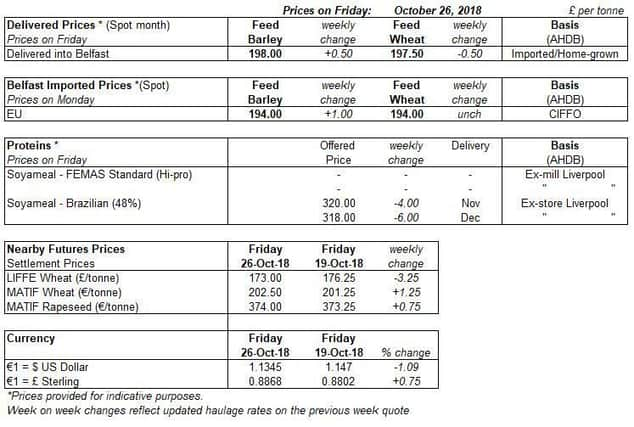MI Northern Ireland Market Report


Last week (Friday-Friday), Chicago wheat futures fell before regaining some ground on Friday (26 Oct). Global wheat futures were partially influenced by upward revisions to global wheat production figures last week, alongside the competitiveness of Black Sea origin wheat and a strengthening US dollar.
Meanwhile, UK feed wheat futures continued to fall.
World wheat and coarse grain production estimates were revised up by 9Mt to 2,081Mt by the International Grains Council (IGC) in their latest estimate released on 25 October. The increase was primarily driven by upward revisions to Russian and European wheat production forecasts. Total world wheat production is forecast at 729Mt, 12Mt higher than its September estimate.
Advertisement
Advertisement
Australian winter wheat production in 2018/19 is now expected to fall to 16.6Mt (13% down on September’s forecast) according to the latest forecast by ABARES, released on 25 October. The latest estimate is a continuation of previous forecasted declines following the drought experienced in much of the country this year. Furthermore, barley production is now forecast to reach just 6.9Mt, 17% down on the previous estimate.
In the UK, Yorkshire bioethanol refinery Ensus announced a suspension to their operations, commencing in late November, due to a fall in global bioethanol prices. The length of the suspension is unknown and will be watched closely in relation to UK wheat supply and demand.
Chicago soyabean futures (Nov-18) continued to decline last week (19 Oct - 26 Oct) pressured by a strengthening dollar and a general bearish trade outlook on US soyabeans. Meanwhile, Paris rapeseed futures (Nov-18) gained marginally on the week, with prices supported partly by global production worries.
At a European level, the rapeseed planted area for the 2019/20 crop was estimated at 6.22Mha by consultancy firm Strategie Grains last week. If realised, this would be a 9% year-on-year drop and the lowest planted area since 2008/09. The estimated decline is partially due to increased price competitiveness of winter cereals versus rapeseed, along with dry conditions during planting and key establishment phases. The firm also cut 2018/19 production to 19.83Mt, a 0.7Mt fall from its September estimates and a 10.7% fall from 2017/18.
Advertisement
Advertisement
On Friday (26 Oct), Australian government agency ABARES revised its estimate for Australian canola production to 2.2Mt, a 20% fall from its previous estimate in September. The reduction comes as a result of the severe drought impacting the country and if realised would be 1.4Mt lower than production in 2017/18 and the smallest crop since 2009/10 (USDA).